Lid-Driven Chamber with 3D Elliptical Obstacle under the Impacts of the Nano-Properties of the Fluid, Lorentz Force, Thermal Buoyancy, and Space Porosity
Abstract
:1. Introduction
- The use of solid metal particles in a liquid enhances its ability to conduct heat.
- The application of a magnetic field on a flow affects its trajectory and velocity, which either negatively or positively effects the thermal transfer rate.
- Using zigzagged walls for rooms instead of flat walls enhances heat transfer.
- Using an elliptical shape for the baffles instead of a circular shape may improve heat transfer.
- This study is a 3D heated elliptical obstacle enclosed in the middle of a chamber. The lower end of the room is zigzagged, while the upper end is horizontally movable. The space between the room walls and the elliptical obstacle is filled with a hybrid nanofluid containing 4% nanoparticles (Al2O3-Cu/water). The magnetic field is also applied to the present system.
2. Mathematical Model and the Study Configuration
2.1. Mathematical Model
| Dimensionless Number | Physical Meaning |
| Reynolds (Re) | Determines wall speed |
| Grashof (Gr) | Determines the thermal buoyancy strength |
| Richardson (Ri) | Determines the ratio between natural and forced convection |
| Darcy (Da) | Shows the permeability of the space |
| Hartmann (Ha) | Controls the strength of the magnetic field |
2.2. Boundary Conditions
Total Entropy Generation
3. Numerical Method and Validation
3.1. Computation Procedure
3.2. Validation
4. Results and Discussion
5. Conclusions
- Increasing the value of Da and/or Re increases the average Nu of the obstacle, and therefore the heat transfer rate increases in terms of these elements. Here we can say that increasing the speed of wall movement and/or the porosity of the space is suitable for cooling activities.
- The magnetic field applied to the present system decreases the Nu value of the elliptical obstacle and hampers the thermal transfer activity. Hence, this case can be applied to thermal insulators.
- Rotating the cylinder from the horizontal position to the vertical position increases the heat transfer; therefore, the first case is suitable for thermal insulation cases, while the second is the best for cooling applications.
Author Contributions
Funding
Institutional Review Board Statement
Informed Consent Statement
Data Availability Statement
Acknowledgments
Conflicts of Interest
References
- Laidoudi, H.; Ameur, H. Investigation of the mixed convection of power-law fluids between two horizontal concentric cylinders: Effect of various operating conditions. Therm. Sci. Eng. Prog. 2020, 20, 100731. [Google Scholar] [CrossRef]
- Laidoudi, H.; Helmaoui, M.; Bouzit, M.; Ghenaim, A. Natural-convection of Newtonian fluids between two concentric cylinders of a special cross-sectional form. Therm. Sci. 2021, 25, 3701–3714. [Google Scholar] [CrossRef]
- Alshare, A.; Abderrahmane, A.; Guedri, K.; Younis, O.; Fayz-Al-Asad, M.; Ali, H.M.; Al-Kouz, W. Hydrothermal and Entropy Investigation of Nanofluid Natural Convection in a Lid-Driven Cavity Concentric with an Elliptical Cavity with a Wavy Boundary Heated from Below. Nanomaterials 2022, 12, 1392. [Google Scholar] [CrossRef] [PubMed]
- Abderrahmane, A.; Qasem, N.A.; Younis, O.; Marzouki, R.; Mourad, A.; Shah, N.A.; Chung, J.D. MHD HybridNanofluid Mixed Convection Heat Transfer and Entropy Generation in a 3-D Triangular Porous Cavity with Zigzag Wall and Rotating Cylinder. Mathematics 2020, 10, 769. [Google Scholar] [CrossRef]
- Alsabery, A.I.; Ismael, M.A.; Chamkha, A.J.; Hashim, I. Numerical Investigation of Mixed Convection and Entropy Generation in a Wavy-Walled Cavity Filled with Nanofluid and Involving a Rotating Cylinder. Entropy 2018, 20, 664. [Google Scholar] [CrossRef] [Green Version]
- Hussain, S.; Jamal, M.; Ahmed, S.E. Hydrodynamic forces and heat transfer of nanofluid forced convection flow around a rotating cylinder using finite element method: The impact of nanoparticles. Int. Commun. Heat Mass Transf. 2019, 108, 104310. [Google Scholar] [CrossRef]
- Jasim, L.M.; Hamzah, H.; Canpolat, C.; Sahin, B. Mixed convection flow of hybrid nanofluid through a vented enclosure with an inner rotating cylinder. Int. Commun. Heat Mass Transf. 2020, 121, 105086. [Google Scholar] [CrossRef]
- Chatterjee, D.; Gupta, S.K.; Mondal, B. Mixed convective transport in a lid-driven cavity containing a nanofluid and a rotating circular cylinder at the center. Int. Commun. Heat Mass Transf. 2014, 56, 71–78. [Google Scholar] [CrossRef]
- Selimefendigil, F.; Oztop, H.F.; Abu-Hamdeh, N.H. Mixed convection due to a rotating cylinder in a 3D corrugated cavity filled with single walled CNT-water nanofluid. J. Therm. Anal. 2018, 135, 341–355. [Google Scholar] [CrossRef]
- Abdulsahib, A.D.; Al-Farhany, K. Numerical Investigation of the nanofluid mixed convection on two layers enclosure with rotating cylinder: High Darcy Number Effects. IOP Conf. Ser. Mater. Sci. Eng. 2020, 928, 22001. [Google Scholar] [CrossRef]
- Laidoudi, H.; Makinde, O.D. Computational study of thermal buoyancy from two confined cylinders within a square enclosure with single inlet and outlet ports. Heat Transfer. 2020, 50, 1335–1350. [Google Scholar] [CrossRef]
- Helmaoui, M.; Laidoudi, H.; Belbachir, A.; Ayad, A.; Ghaniam, A. Forced convection heat transfer from a pair of circular cylinders confined in ventilated enclosure. Diffus. Found. 2020, 26, 104–111. [Google Scholar] [CrossRef]
- Chatterjee, D.; Halder, P. Magnetoconvective Transport in a Lid-Driven Square Enclosure with Two Rotating Circular Cylinders. Heat Transf. Eng. 2015, 37, 198–209. [Google Scholar] [CrossRef]
- Alsabery, A.I.; Ghalambaz, M.; Armaghani, T.; Chamkha, A.; Hashim, I.; Pour, M.S. Role of Rotating Cylinder toward Mixed Convection inside a Wavy Heated Cavity via Two-Phase Nanofluid Concept. Nanomaterials 2020, 10, 1138. [Google Scholar] [CrossRef] [PubMed]
- Azizul, F.; Alsabery, A.I.; Hashim, I. Heatlinesvisualisation of mixed convection flow in a wavy heated cavity filled with nanofluids and having an inner solid block. Int. J. Mech. Sci. 2020, 175, 105529. [Google Scholar] [CrossRef]
- Azizul, F.M.; Alsabery, A.I.; Hashim, I.; Chamkha, A.J. Heatline visualization of mixed convection inside double lid-driven cavity having heated wavy wall. J. Therm. Anal. 2020, 145, 3159–3176. [Google Scholar] [CrossRef]
- Bendrer, B.; Abderrahmane, A.; Ahmed, S.E.; Raizah, Z.A. 3D magnetic buoyancy-driven flow of hybrid nanofluids confined wavy cubic enclosures including multi-layers and heated obstacle. Int. Commun. Heat Mass Transf. 2021, 126, 105431. [Google Scholar] [CrossRef]
- Azzawi, I.D.J.; Al-damook, A. Multi-objective optimum design of porous triangular chamber using RSM. Int. Commun. Heat Mass Transf. 2022, 130, 105774. [Google Scholar] [CrossRef]
- Afrand, M.; Pordanjani, A.H.; Aghakhani, S.; Oztop, H.F.; Abu-Hamdeh, N. Free convection and entropy generation of a nanofluid in a tilted triangular cavity exposed to a magnetic field with sinusoidal wall temperature distribution considering radiation effects. Int. Commun. Heat Mass Transf. 2020, 112, 104507. [Google Scholar] [CrossRef]
- Chauhan, M.K.; Dutta, S.; More, B.S.; Gandhi, B.K. Experimental investigation of flow over a square cylinder with an attached splitter plate at intermediate reynolds number. J. Fluids Struct. 2018, 76, 319–335. [Google Scholar] [CrossRef]
- Rastan, M.R.; Sohankar, A.; Moreau, D.J.; Doolan, C.J.; Awasthi, M. Modulation of aerodynamic characteristics of a finite wall-mounted square cylinder through steady jet injection. Exp. Therm. Fluid Sci. 2020, 112, 109976. [Google Scholar] [CrossRef]
- Acharya, N.; Chamkha, A.J. On the magnetohydrodynamic Al2O3-water nanofluid flow through parallel fins enclosed inside a partially heated hexagonal cavity. Int. Commun. Heat Mass Transf. 2022, 132, 105885. [Google Scholar] [CrossRef]
- Sepyani, M.; Shateri, A.; Bayareh, M. Investigating the mixed convection heat transfer of a nanofluid in a square chamber with a rotating blade. J. Therm. Anal. 2018, 135, 609–623. [Google Scholar] [CrossRef]
- Reddy, P.S.; Sreedevi, P. Effect of thermal radiation and volume fraction on carbon nanotubes based nanofluid flow inside a square chamber. Alex. Eng. J. 2020, 60, 1807–1817. [Google Scholar] [CrossRef]
- Hansda, S.; Pandit, S.K.; Sheu, T.W.H. Thermosolutal discharge of double diffusion mixed convection flow with Brownian motion of nanoparticles in a wavy chamber. J. Therm. Anal. 2021, 147, 7007–7029. [Google Scholar] [CrossRef]
- Lzadi, M.; Sheremet, M.A.; Mehryan, S.A.M. Natural convection of a hybrid nanofluid affected by an inclined periodic magnetic field within a porous medium. Chin. J. Phys. 2020, 65, 447–458. [Google Scholar]
- Chamkha, A.J.; Selimefendigil, F.; Oztop, H.F. Effects of a Rotating Cone on the Mixed Convection in a Double Lid-Driven 3D Porous Trapezoidal Nanofluid Filled Cavity under the Impact of Magnetic Field. Nanomaterials 2020, 10, 449. [Google Scholar] [CrossRef] [Green Version]
- Selimefendigil, F.; Chamkha, A.J. MHD mixed convection of Ag–MgO/water nanofuid in a triangular shape partitioned lid driven square cavity involving a porous compound. J. Therm. Anal. Calorim. 2021, 143, 1467–1484. [Google Scholar] [CrossRef]
- Sun, C.; Yu, B.; Oztop, H.F.; Wang, Y.; Wei, J. Control of mixed convection in lid-driven enclosures using conductive triangular fins. Int. J. Heat Mass Transf. 2011, 54, 894–909. [Google Scholar] [CrossRef]
- Elatar, A.; Teamah, M.A.; Hassab, M.A. Numerical study of laminar natural convection inside square enclosure with single horizontal fin. Int. J. Therm. Sci. 2016, 99, 41–51. [Google Scholar] [CrossRef]
- Laidoudi, H. Enhancement of natural convection heat transfer in concentric annular space using inclined elliptical cylinder. J. Nav. Archit. Mar. Eng. 2020, 17, 89–99. [Google Scholar] [CrossRef]
- Al-Kouz, W.; Al-Muhtady, A.; Owhaib, W.; Al-Dahidi, S.; Hader, M.; Abu-Alghanam, R. Entropy Generation Optimization for Rarified Nanofluid Flows in a Square Cavity with Two Fins at the Hot Wall. Entropy 2019, 21, 103. [Google Scholar] [CrossRef] [PubMed] [Green Version]
- Hussain, S.; Jamal, M.; Geridonmez, B.P. Impact of fins and inclined magnetic field in double lid-driven cavity with Cu–water nanofluid. Int. J. Therm. Sci. 2020, 161, 106707. [Google Scholar] [CrossRef]
- Shamshuddin, M.D.; Abderrahmane, A.; Koulali, A.; Eid, M.R.; Shahzad, F.; Jamshed, W. Thermal and solutal performance of Cu/CuO nanoparticles on a non-linear radially stretching surface with heat source/sink and varying chemical reaction effects. Int. Commun. Heat Mass Transf. 2021, 129, 105710. [Google Scholar] [CrossRef]
- Rashidi, M.M.; Sadri, M.; Sheremet, M.A. Numerical Simulation of Hybrid Nanofluid Mixed Convection in a Lid-Driven Square Cavity with Magnetic Field Using High-Order Compact Scheme. Nanomaterials 2021, 11, 2250. [Google Scholar] [CrossRef] [PubMed]
- Lv, H.; Chen, X.; Zeng, X. Optimization of micromixer with Cantor fractal baffle based on simulated annealing algorithm. Chaos Solitons Fractals 2021, 148, 111048. [Google Scholar] [CrossRef]
- Lv, H.; Chen, X. New insights into the mechanism of fluid mixing in the micromixer based on alternating current electric heating with film heaters. Int. J. Heat Mass Transf. 2021, 181, 121902. [Google Scholar] [CrossRef]
- Lv, H.; Chen, X.; Wang, X.; Zeng, X.; Ma, Y. A novel study on a micromixer with Cantor fractal obstacle through grey relational analysis. Int. J. Heat Mass Transf. 2022, 183, 122159. [Google Scholar] [CrossRef]
- UGhia, U.; Ghia, K.N.; Shin, C.T. High-Re Solutions for Incompressible Flow Using the Navier-Stokes Equations and a Multigrid Method. J. Comput. Phys. 1982, 48, 387–411. [Google Scholar]
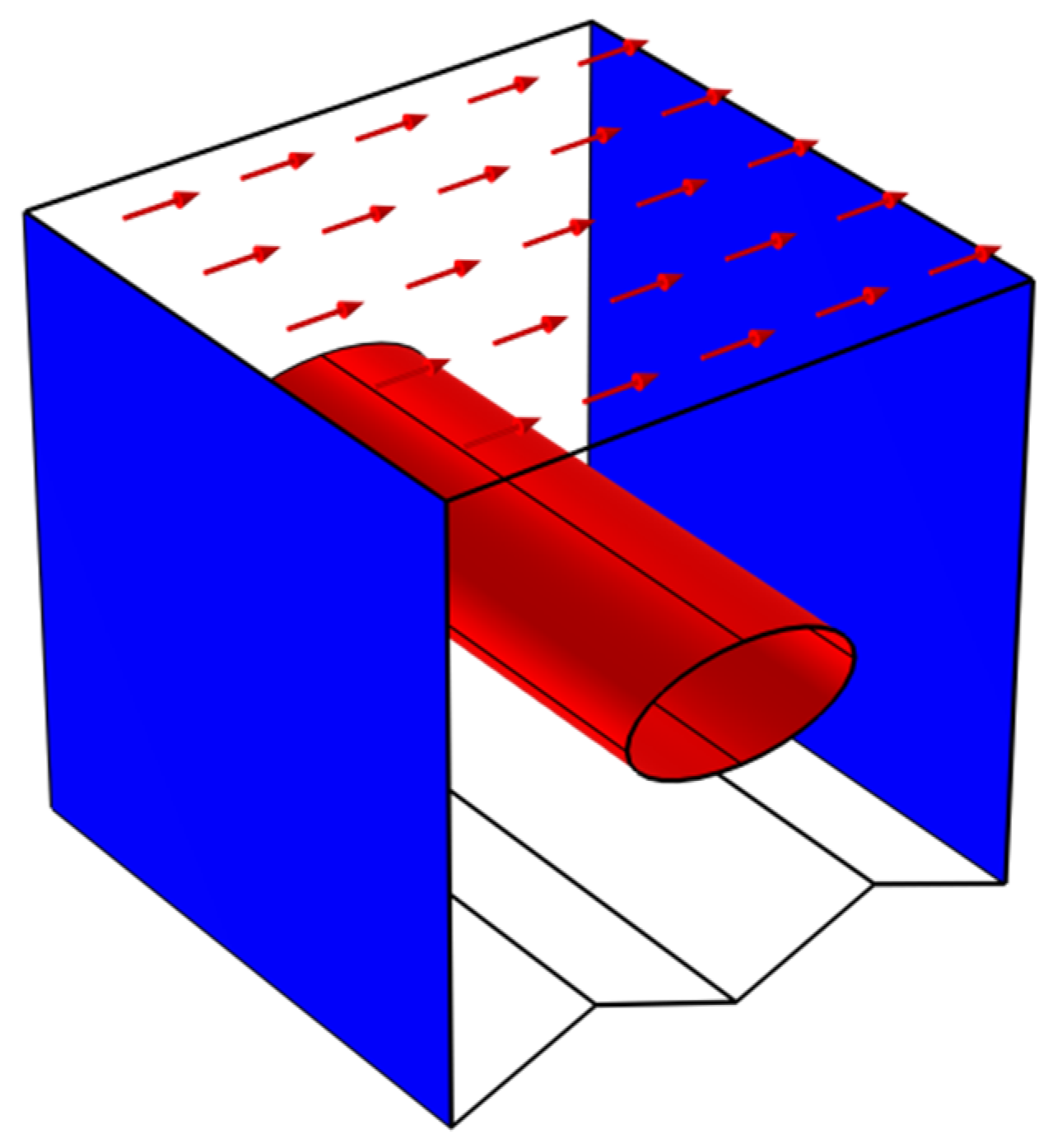
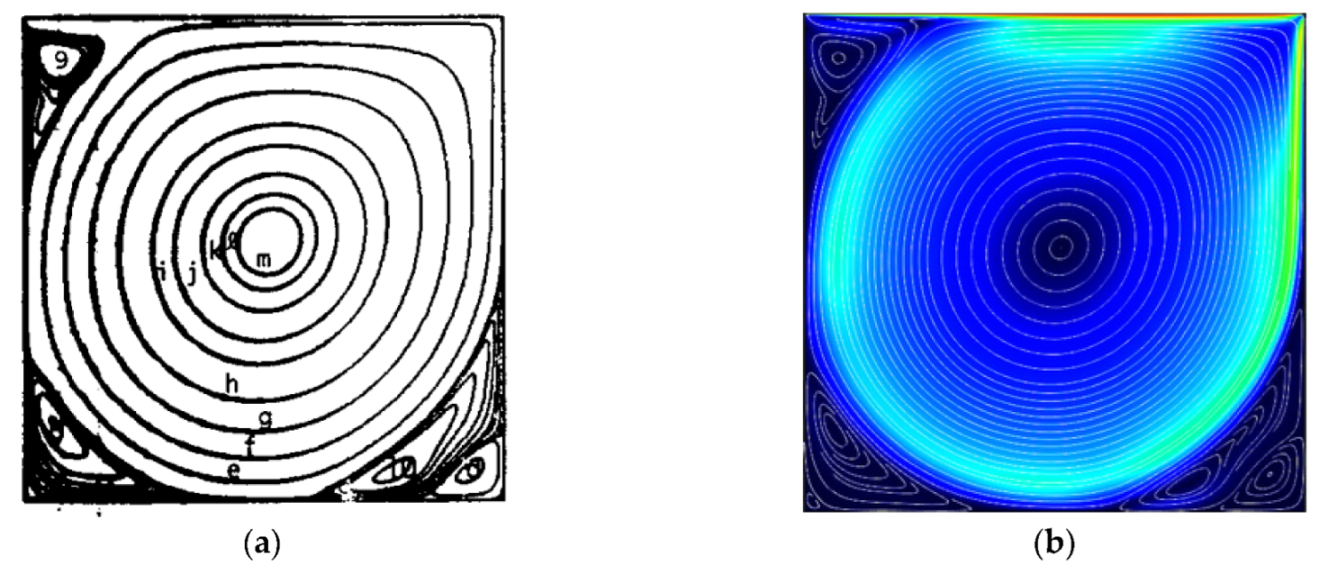
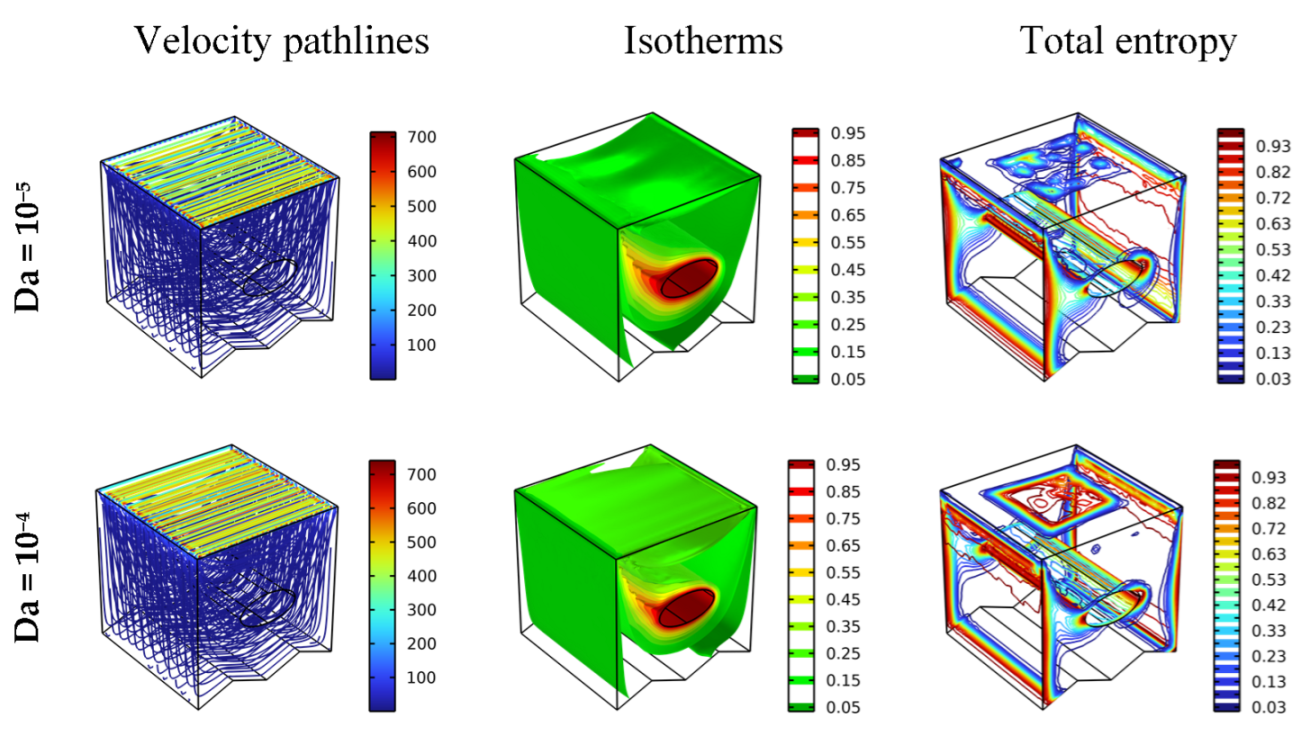


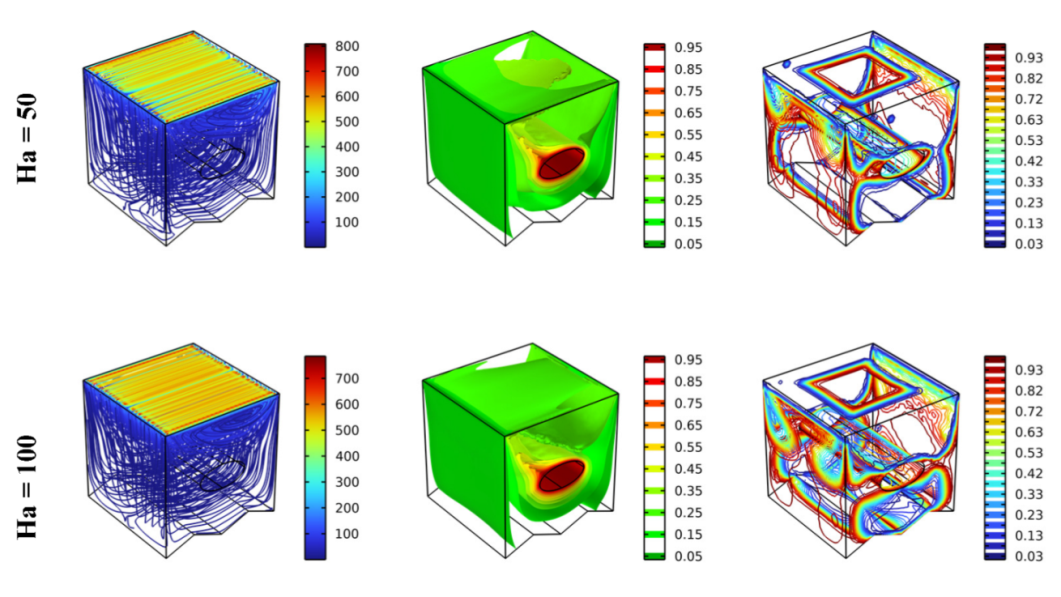
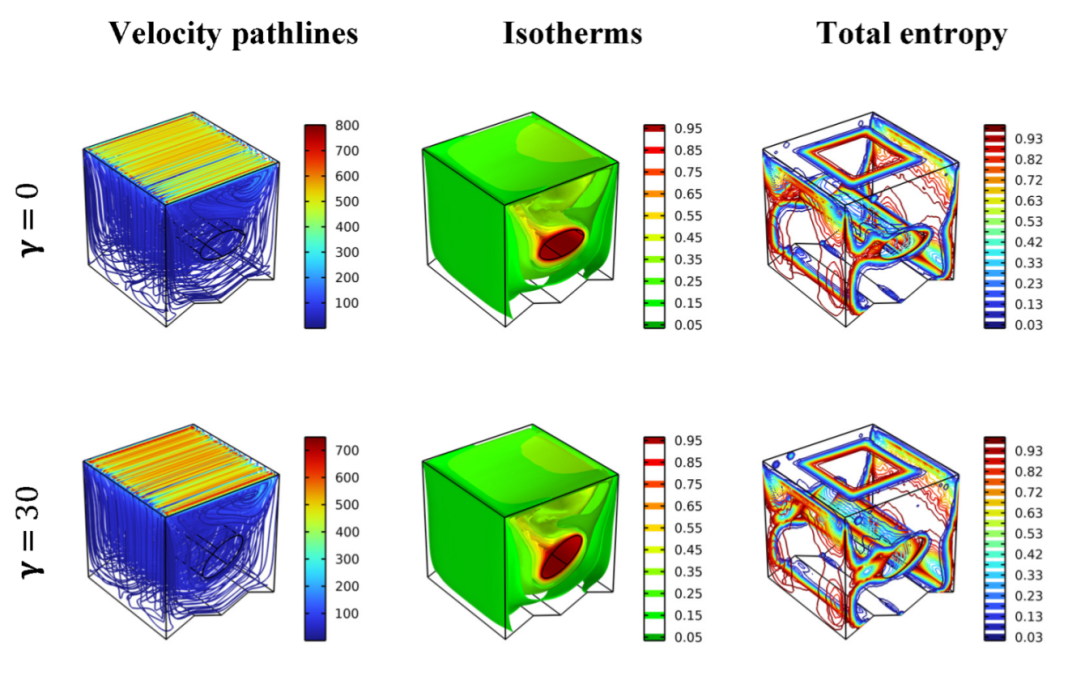


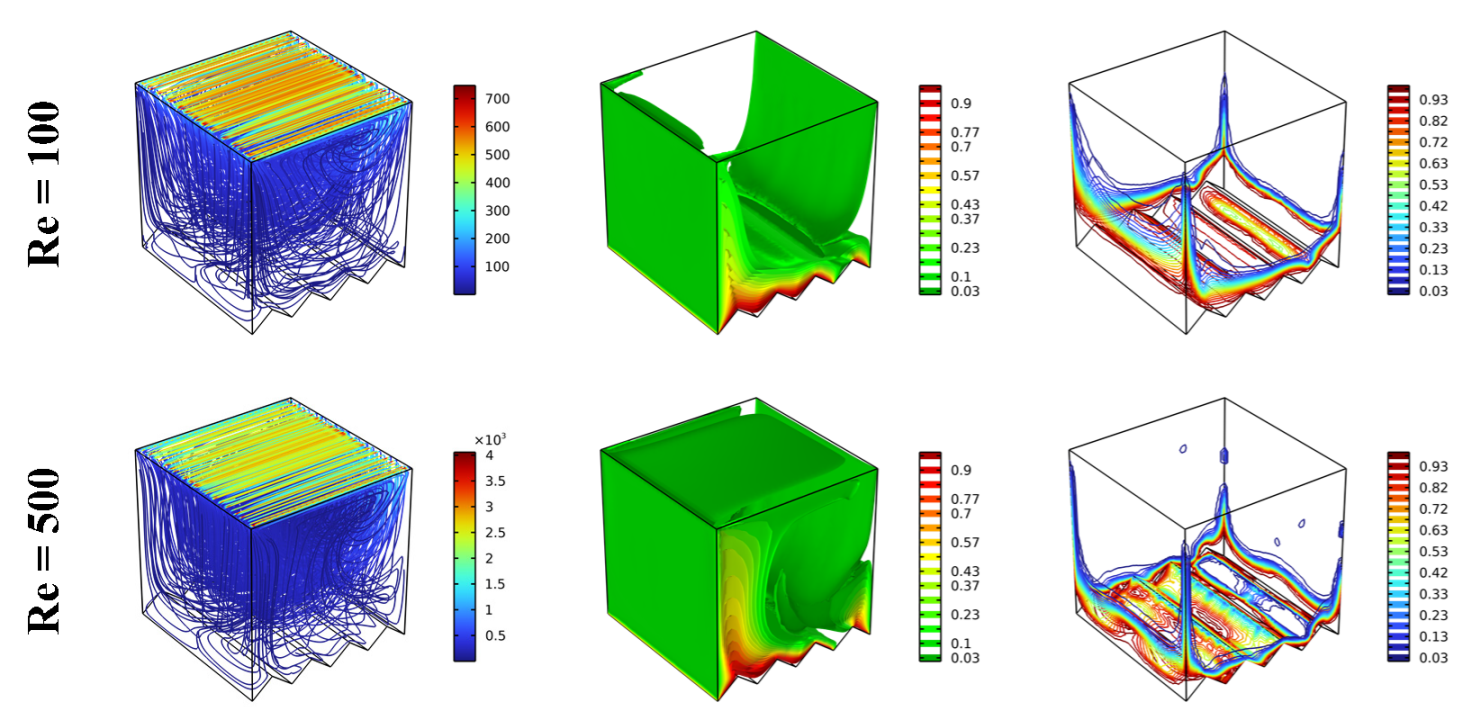
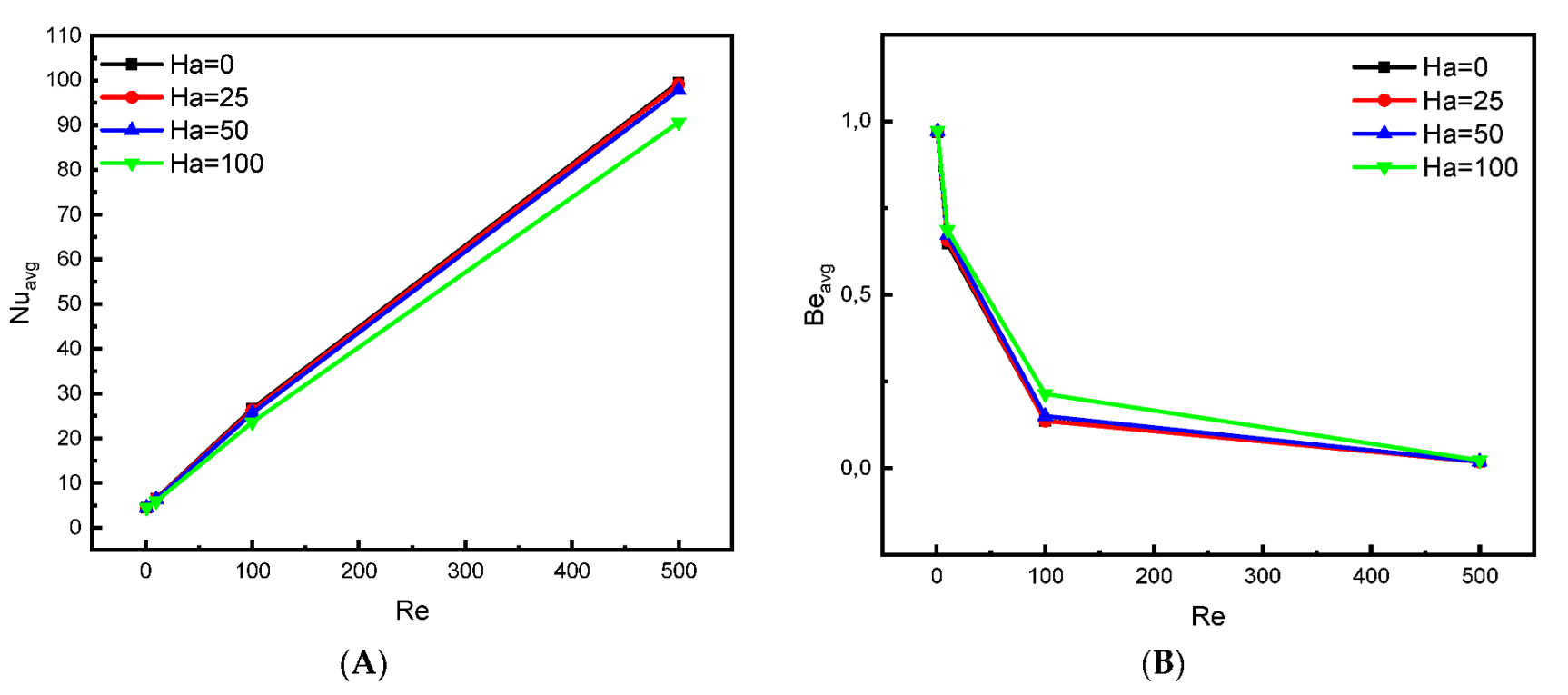
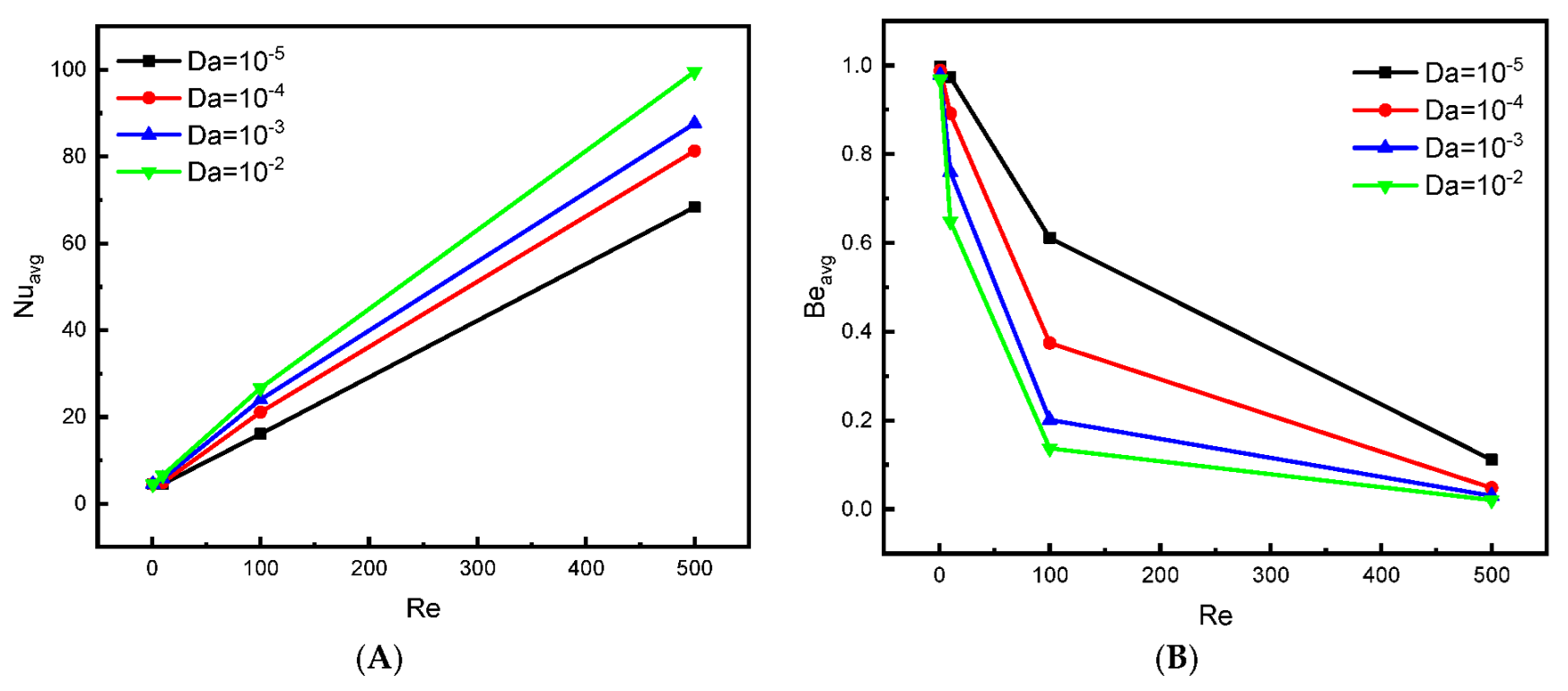
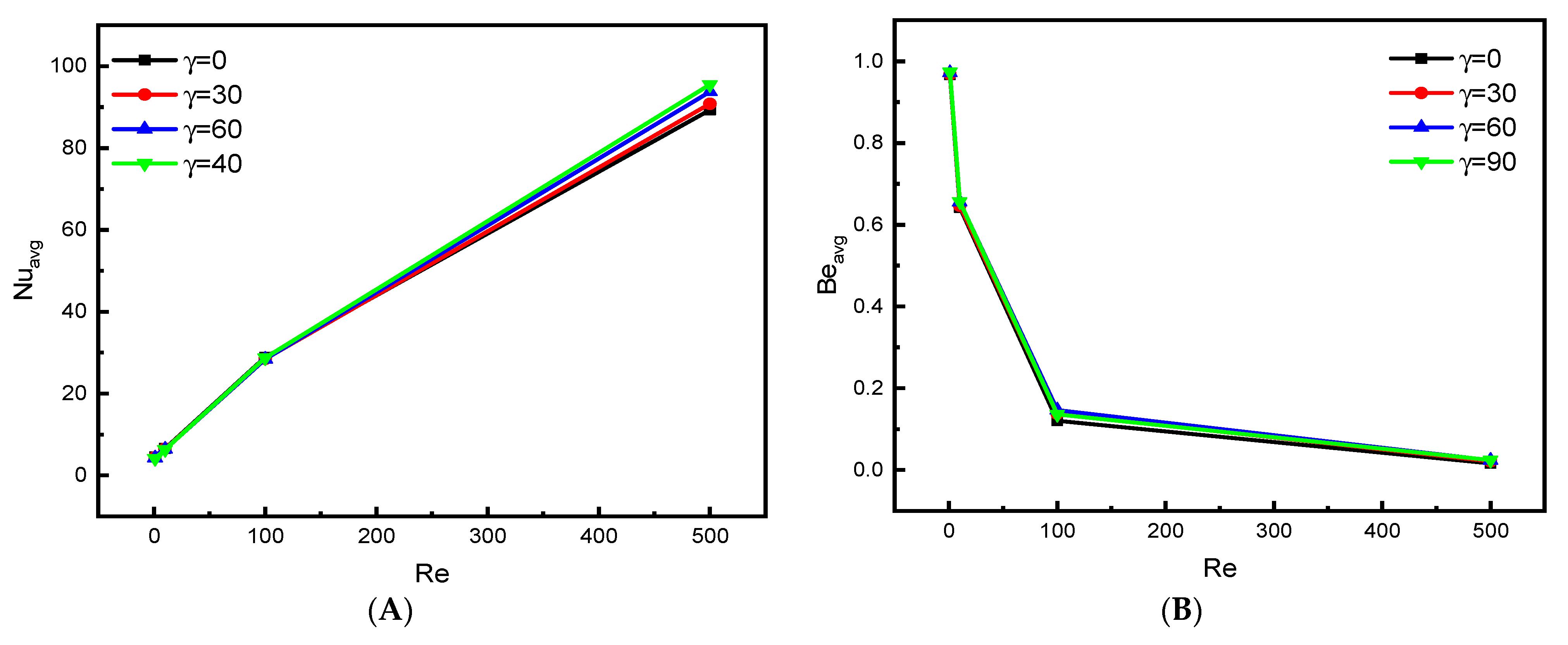
| Thermophysical Properties | water | ||
|---|---|---|---|
| 3970 | 8933 | 997.1 | |
| 765 | 385 | 4179 | |
| 40 | 400 | 0.613 | |
| Property | Correlation |
|---|---|
| Density | |
| Heat capacity | |
| Coefficient of thermal dilatation | |
| Electrical conductivity | |
| Thermal conductivity | |
| Viscosity |
| Thermal Condition | Velocity Condition | |
|---|---|---|
| The left wall | ||
| The right wall | ||
| The top and bottom wall | adiabatic | |
| The top wall | adiabatic | |
| The inner cylinder wall |
| No. of Grid Elements | 53,274 | 93,700 | 218,558 | 629,215 | 2,576,359 |
|---|---|---|---|---|---|
| Nuavg | 6.6421 | 6.5563 | 6.5515 | 6.5432 | 6.5429 |
| Beavg | 0.64964 | 0.64951 | 0.64832 | 0.64832 | 0.64831 |
Publisher’s Note: MDPI stays neutral with regard to jurisdictional claims in published maps and institutional affiliations. |
© 2022 by the authors. Licensee MDPI, Basel, Switzerland. This article is an open access article distributed under the terms and conditions of the Creative Commons Attribution (CC BY) license (https://creativecommons.org/licenses/by/4.0/).
Share and Cite
Laidoudi, H.; Abderrahmane, A.; Saeed, A.M.; Guedri, K.; Younis, O.; Marzouki, R.; Chung, J.D.; Shah, N.A. Lid-Driven Chamber with 3D Elliptical Obstacle under the Impacts of the Nano-Properties of the Fluid, Lorentz Force, Thermal Buoyancy, and Space Porosity. Nanomaterials 2022, 12, 2373. https://doi.org/10.3390/nano12142373
Laidoudi H, Abderrahmane A, Saeed AM, Guedri K, Younis O, Marzouki R, Chung JD, Shah NA. Lid-Driven Chamber with 3D Elliptical Obstacle under the Impacts of the Nano-Properties of the Fluid, Lorentz Force, Thermal Buoyancy, and Space Porosity. Nanomaterials. 2022; 12(14):2373. https://doi.org/10.3390/nano12142373
Chicago/Turabian StyleLaidoudi, Houssem, Aissa Abderrahmane, Abdulkafi Mohammed Saeed, Kamel Guedri, Obai Younis, Riadh Marzouki, Jae Dong Chung, and Nehad Ali Shah. 2022. "Lid-Driven Chamber with 3D Elliptical Obstacle under the Impacts of the Nano-Properties of the Fluid, Lorentz Force, Thermal Buoyancy, and Space Porosity" Nanomaterials 12, no. 14: 2373. https://doi.org/10.3390/nano12142373
APA StyleLaidoudi, H., Abderrahmane, A., Saeed, A. M., Guedri, K., Younis, O., Marzouki, R., Chung, J. D., & Shah, N. A. (2022). Lid-Driven Chamber with 3D Elliptical Obstacle under the Impacts of the Nano-Properties of the Fluid, Lorentz Force, Thermal Buoyancy, and Space Porosity. Nanomaterials, 12(14), 2373. https://doi.org/10.3390/nano12142373









